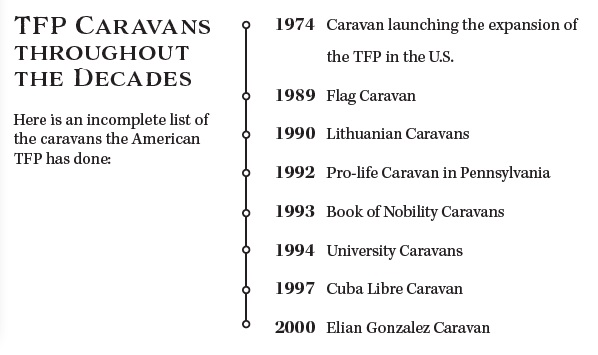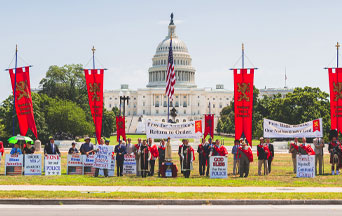
The American Society for the Defense of Tradition, Family and Property (TFP) employs many different ways of reaching out to the public. Some are common like online videos, web sites, e-mails, newsletters, mass mailings, talks, and street campaigns. There is an outreach that is unique to the TFP: the TFP caravans.
A large number of the videos posted on the various TFP social media platforms are excerpts from a TFP caravan. They have drawn a following among conservatives worldwide. Nothing is more satisfying for young conservatives than watching liberals be excoriated in a candid discussion. However, viewership has crossed into the liberal camp. They have taken notice. And, it scares them.
In this article, we will explore the truth, the legends, and the myths of the TFP caravans. How did this celebrated form of outreach start? Why is it so effective? Why do liberals fear it so much? And, most importantly, why does it inspire the young and the old alike?
What is a TFP campaign?
It is a form of outreach where volunteers engage with the man in the street with literature or a discussion while holding banners and the TFP grand standard, and wearing the TFP capes.
What is a TFP caravan?
It is a street campaign taken to the road spending the nights away from a TFP center, touring to different cities for days or months at a time.
What is a caravaner?
A volunteer who travels with a TFP caravan.
The TFP Caravan Is Born
The first TFP caravans were officially launched in a solemn ceremony on July 23, 1969 in Sao Paulo, Brazil by the Brazilian TFP’s founder, Professor Plinio Corrêa de Oliveira. The importance of the launching was such that he said “it will have more repercussion [in the fight against communism] than the moon landing.”1 Though a technological wonder, the moon landing did little to oppose the advance of communism and other threats in the world. The caravan, however, was designed for that purpose.
Eternal and Natural Law: The Foundation of Morals and Law
The statistics for the Brazilian caravans are incomplete. Here is a rough estimate.2 They have traveled about five million kilometers (approximately 3,106,856 miles), distributed over twenty million publications, and campaigned in over 20,278 cities and municipalities, and countless small villages and settlements, reaching the northernmost regions of the Amazon where few outsiders have stepped foot.
Its effectiveness was proven repeatedly. In many countries where the TFP has started and the conditions were right, caravans have been done. This includes Argentina, Chile, Colombia, Bolivia, Uruguay, Ecuador, Costa Rica, Australia, France, Germany, Italy, Spain, Portugal, Ireland, the Netherlands, Canada, and the United States.
In the United States, the first caravan was launched in 1974 after a solemn Mass at the foot of the Memorial Cross at St. Clement’s Island in Maryland, where the first Catholic Mass was celebrated in the English-speaking colonies.3 It went from New York to California, passing through the Southern states.
A Campaign from City to City, State to State
What is the difference between a TFP campaign and a TFP caravan?
A TFP street campaign is a form of street activism where TFP volunteers engage directly with the man in the street discussing the most important issues of the day. The volunteers wear the distinctive red capes, hold poster signs, banners, and the eighteen-foot grand standard of the TFP, and are frequently accompanied by a band or even a lone bagpiper. It was designed by Professor Corrêa de Oliveira as a means to reach public opinion bypassing mass media.
A TFP caravan is a campaign on tour. Typically, the volunteers sleep away from a TFP center. Anywhere from four to forty plus TFP volunteers will travel in a caravan. By going mobile, a caravan amplifies the effect of a street campaign in an incalculable way similar to the reverberation of several drums beating to the same rhythm or when explosives are detonated in a precise sequence. The strength of the repercussion or the explosion is greater than their sums. In physics, this behavior is called constructive interference.4
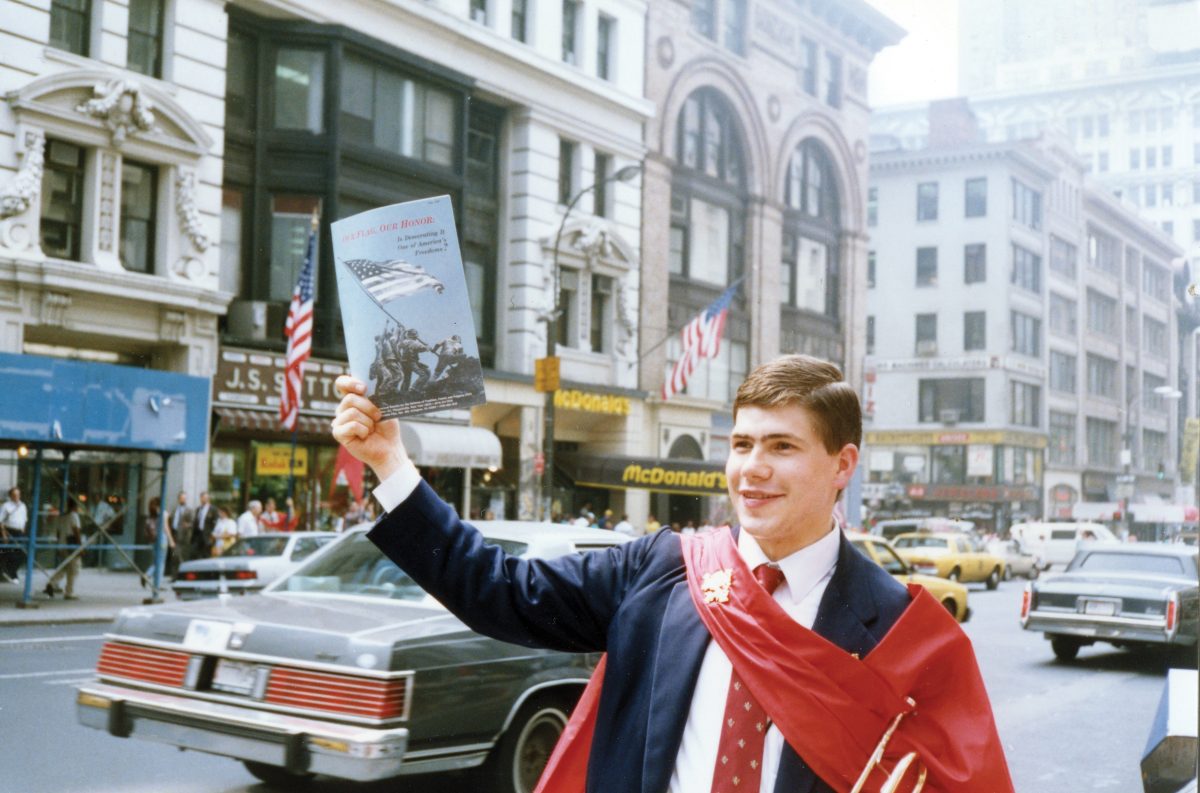
This amplification could be observed during the Flag Caravan, the biggest caravan the American TFP has done to date. It was a petition drive to defend the honor of the American flag involving as many as sixty volunteers in as many as five vehicles. It visited many major cities in the continental United States. At the start, there was a general apathy to prevent the flag from desecration. As the caravan went from state to state, the public opinion’s awareness on the issue grew exponentially, and the caravaners noticed a shift. The caravaners collected over 130,000 signatures over the summer which was submitted to White House Chief of Staff, John Sununu, and Senator Bob Dole. The issue stayed hot in the decades that followed. In fact, the 104th to 109th Congresses voted on a constitutional amendment to protect the flag from desecration.5
Opposing the Mass Media Narrative
The TFP caravan was developed to bypass liberal mass media. Long before the advent of social media, there was no way to challenge the liberal narrative of the radio, TV networks, literature, Hollywood, and newspapers. It became even more difficult when many celebrities, religious leaders, and other social influencers toed the same narrative. The TFP campaigns and caravans proved to be effective in opposing the liberal narrative.
The caravans were particularly effective in smaller cities where the public is not as exposed to the constant barrage of liberal propaganda. Not everyone is equally tuned in or online. There is a large part of the population whose opinions are still formed in conversations. Marcos Aurelio Vieira, who was a captain of a permanent caravan in Brazil, noted how easy it was to refute the liberal narrative in the most remote places in Brazil. He found there is a correlation between the size of the city and how much people toed the liberal narrative. This is also true in the United States.
 Learn All About the Prophecies of Our Lady of Good Success About Our Times
Learn All About the Prophecies of Our Lady of Good Success About Our Times
This was noticeable with the Elian Gonzalez Caravan. The campaign was about the sad case of a sixyear-old Cuban boy found floating in an inner tube off the coast of Florida. The boy’s mother had sacrificed everything, including her own life, to get him to the United States. On April 22, the Clinton administration sent armed agents to extract the boy from his Floridian relatives. The traumatic event was caught on film and it shocked the whole world. Liberal news sources acted quickly, giving the narrative that this is a paternity issue, so the boy needed to be reunited with his biological father back in Cuba. In reality, it was something much more. It was a proxy battle between the communist dictator Fidel Castro, and the free world.
On May 3, the American TFP sent out a caravan to spread flyers of a published statement, Where is Elian’s Journey Leading Us, which challenged the narrative. It campaigned in thirty-three cities, in thirty-two days, and passed out 50,000 flyers.6 The caravan targeted the outlying cities of Miami where the caravan’s message was received readily from the seamstress to the high school student.
Breaking Media Silence
At times, the strategy of the liberal narrative is to impose a silence over an inconvenient truth. Refusing to report on an issue is tantamount to saying there is nothing to see here. This is the very strategy conservative social media has opposed. However, if an issue becomes viral, the liberal media is no longer able to impose a “campaign of silence” over it.
The caravan is effective in breaking the media silence. During Lithuania’s bid for independence, the silence the media imposed on the issue was so effective, few even knew the country existed, much less that it was fighting for her independence. The TFPs and like-minded associations heard her plight and launched a worldwide campaign to support the freedom of Catholic Lithuania from the Soviet Union. It is the largest international campaign of the TFP to date, and the campaign where the most caravans participated. An official number is impossible to ascertain, but a rough estimate is that there were more than twenty caravans worldwide.
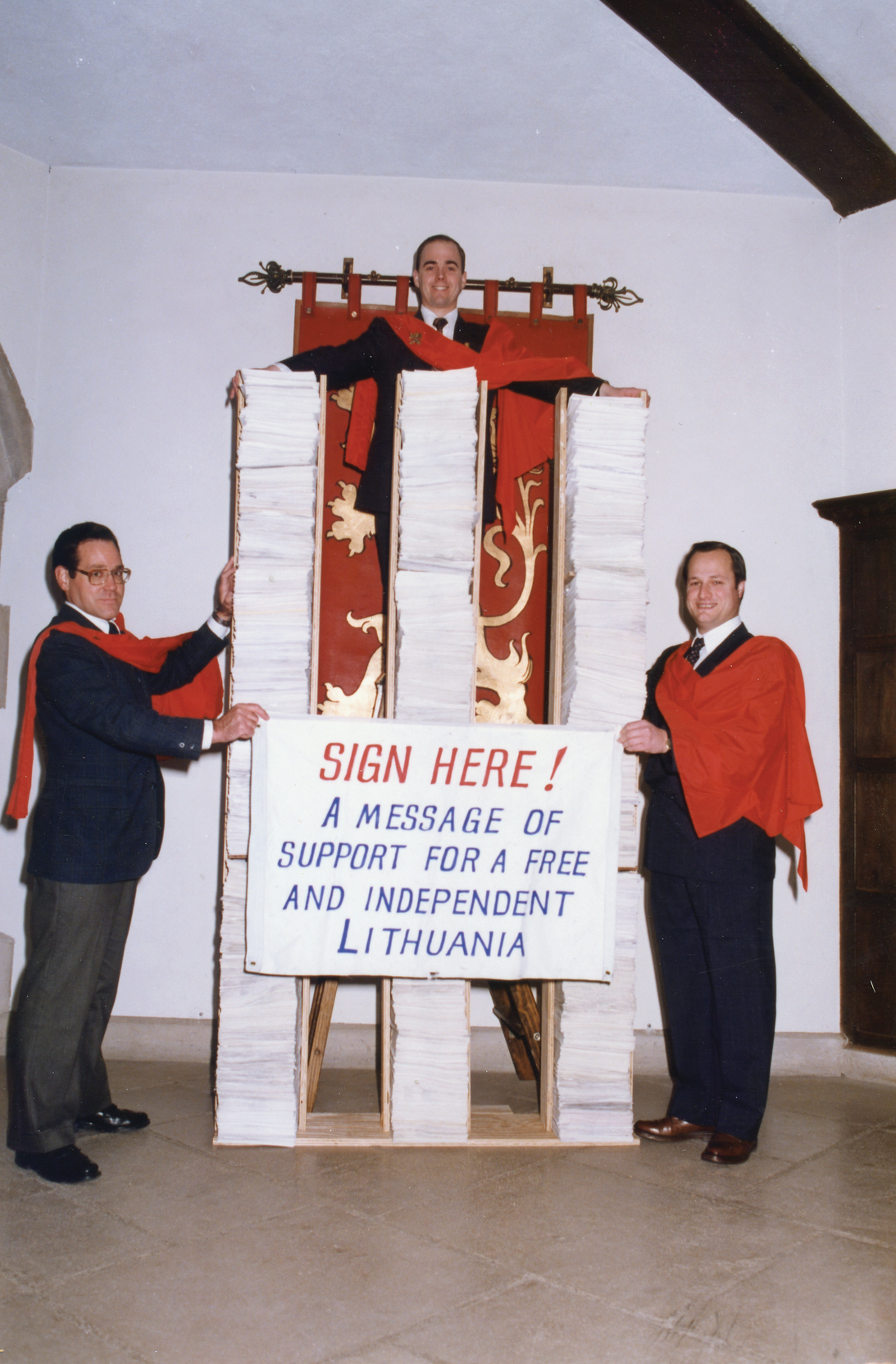
This campaign, largely thanks to the caravans, collected over 5.2 million verified signatures demanding the freedom of Lithuania, an accomplishment registered in the World Book of Records. The signatures were presented to the provisional Lithuanian Parliament and was publicized throughout Lithuania. Lithuanians received the news in tears. Months later, Soviet President Mikhail Gorbachev rolled in with tanks to suppress the Lithuanians. By then, the media was no longer able to maintain silence over the conflict. They caught on film the dramatic crushing of Lithuanians under Soviet tanks, and images quickly spread worldwide. The whole world clamored for Lithuania’s freedom. World leaders made official statements in support of Lithuania. The Soviets were forced to march out.
How Successful Have the TFP Caravans Been?
It is difficult to measure the success of the caravans when polls and statistics are unavailable. However, there is an objective way of measuring it.
There are “forces” that can influence a change in public opinion. When they all work together to attain the same or similar goals, this can be called a “machinery.” In a broad and loose sense, this can include the government, newspapers, radio, broadcast, literature, church leaders, academia, celebrities, social media, influencers, and so on.
Logically speaking, the greater the “machinery” promoting an agenda is, the greater its chance of success. So an effort organized against this machinery can be judged successful if the agenda is delayed considerably or is stopped altogether. As was mentioned, the caravan was designed for this.
10 Razones Por las Cuales el “Matrimonio” Homosexual es Dañino y tiene que Ser Desaprobado
The machinery promoting communist ideals was successful in many countries in Asia and Africa. In Brazil and South America, especially with the support of the liberal clergy, it should have been insurmountable. Yet, today, Brazil and most of South America are free countries, thanks to the caravans.
When ideas of class warfare and land reform spread like wildfire in Catholic circles through the Cursilhos de Cristandade7 movement, Brazil was in clear and present danger of falling to communism. Left unchecked, enough communist guerillas could have been recruited from the movement, pressed into guerilla warfare, and usurped the government similar to what happened in Cambodia. The TFP caravans sounded the alarm. The movement was unmasked. The armed guerillas in Brazil failed to grow strong enough to usurp the country.
Closer to home, in the United States, California’s 2008 Proposition 8 was a referendum to define marriage as between one man and one woman in their constitution. The machinery against it was enormous. It was expected to be rejected by a comfortable margin. The TFP caravan campaigned throughout the state twice. California voters approved the referendum 52% to 48%.8
The best example is related to the Lithuanian caravans. The machinery that lavished prestige on the Soviet dictator Gorbachev was one of the greatest in human history, according to Professor Corrêa de Oliveira. He walked onto the world stage seen as the “messiah” that would abolish the Cold War and end the threat of nuclear annihilation. The Lithuanian affaire discredited him so much that he lost his leadership position. Soon the only job he could get was to be the brand ambassador for Pizza Hut in Russia, a far cry from his position of world influence at the height of his career. When he died, the world gave little notice.
10 Reasons Why Abortion Is Evil
In all these cases, far be it from us to claim that the caravans were the only effort that opposed the agendas mentioned. There were, of course, others. However, even if what the caravans contributed to the overall effort was equivalent to that of a straw, the importance of that straw in breaking the camel’s back cannot be denied.
The Myths of the Caravan
The myths created by the TFP caravans have spread far and wide. For this article, we can define a myth as impressions that are inexplicable.
One time, a liberal journalist wrote in his article that he didn’t care what the readers thought, there were no less than 300 TFP volunteers passing through the city the previous day. In truth, there were only nine caravaners. It is inexplicable why he thought there were thirty times the number.
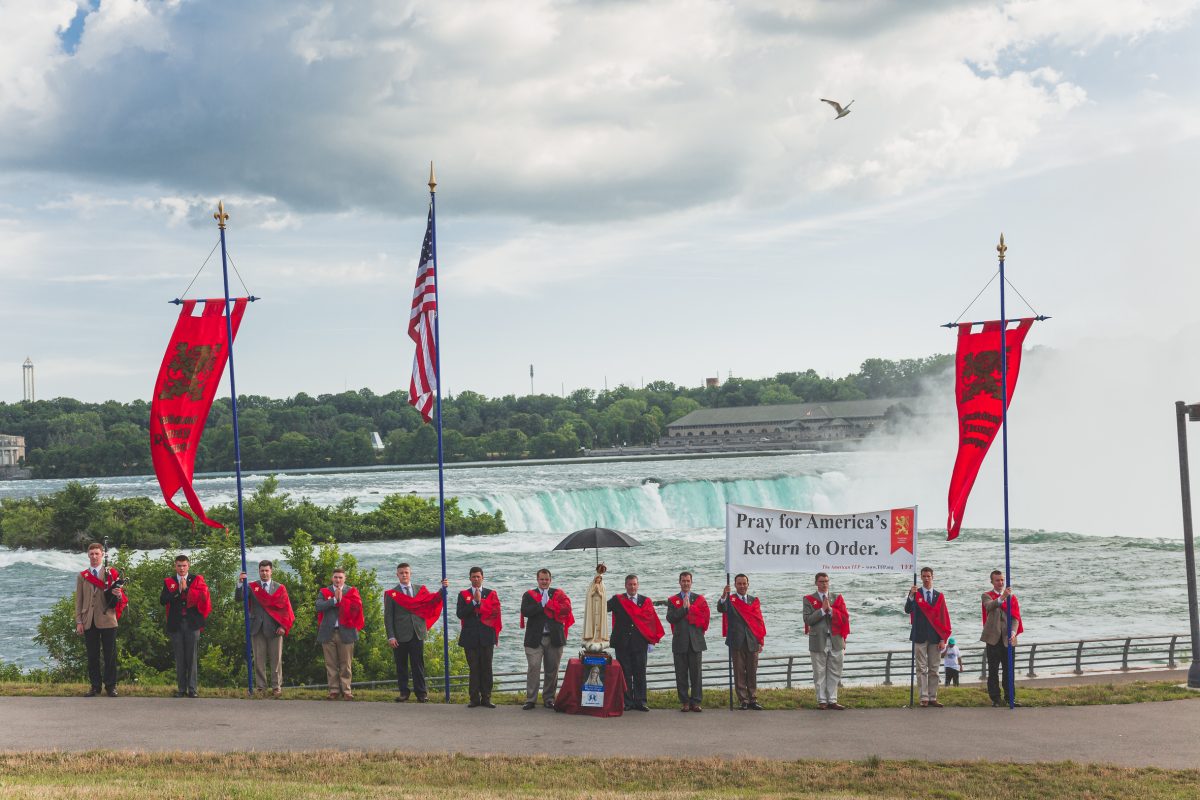
A California woke professor wrote about how a caravan of thirty carloads of TFP volunteers “descended” to support a parish priest’s fight against immodesty. There were no more than five vehicles.
A European Union Member of Parliament called the TFP a politically active trans-national social and religious order of “warrior monks” using idealized medieval symbols in their street campaigns to oppose abortion, communism, and gender theory.9 Though meant to be a scathing accusation, it would be an honor for any conservative to be called pro-life, anti-communist, anti-transgenderism, Catholic, and medieval “warrior monks.” However, no TFP caravaners are medieval, military, or monks.
The Legends of the Caravan
Whereas the status of “myth” is drawn purely from impressions, the status of “legend” is based on facts as when someone is called a military legend or a sports legend. We can define legend as something that is larger than a life10, or exploits that cause admiration.11 Here is list of things that many considered legendary.
- Indomitable Prayer Warriors
During the Fifty-State Capitol Caravan, a TFP volunteer confronted an armed BLM activist with nothing but a rosary. This iconic stand-off was captured on film. The activist is calmed by the rosary brandishing caravaner and walks away with his group of agitators without disrupting the rosary rally.
- Unflappable Calm Demeanor
In the Proposition 8 Caravan, all the caravaners calmly held their ground while what seemed like all the students of University of California, Berkeley surrounded them fuming with anger. In a caravan against socialism, a very intimidating large man chased after the caravan’s cameraman. A slim caravaner stepped in front of him to stop him from harming anybody. The difference in size looked like a David and Goliath scene. The caravaner de-escalated the situation, and the man left.
- Respected and Even Feared
Once a woman emptied a whole canister of pepper spray on a caravaner’s face. Despite the burn, he advanced toward all the counter-protesters and forced them to run across the street in fear.
- Resilient Campaigners in Extreme Weather
During a Traditional Marriage Caravan, the winds and rain of an incoming hurricane raged while the caravaners, drenched to the bone, finished off the campaign.
- Masters of Street Debate
Once, several caravaners debated with Harvard grad students studying international politics. A student who signed the petition drive told the caravaners the liberal students were getting counterarguments from their professor. Without realizing it, the caravaners were in a proxy debate with a Harvard professor.
- Sense of Sacrifice
Perhaps, the most legendary status of all goes to Mr. Fred Portfilio and Mr. Daryl Huang, two members who died in a vehicle accident during the Lithuanian campaign. Their deaths inspired Lithuanians to lay down their lives for their country’s freedom. The Lithuania government officially registered their deaths in their records so future generations will not forget their sacrifice.
TFP Caravans throughout the Decades
Here is an incomplete list of the caravans the American TFP has done:
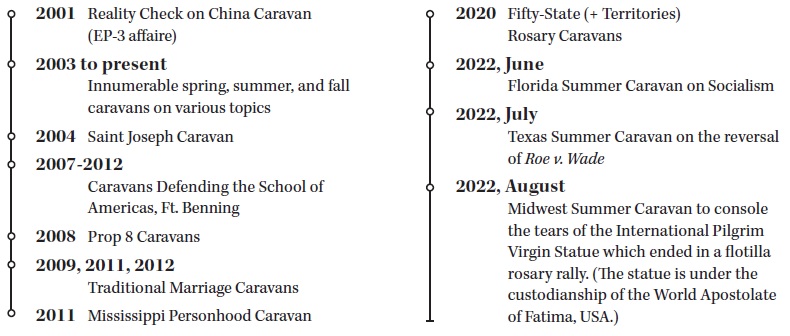
The Sense of the Epic and the Call for Heroism
The caravan has an attraction that is hard to explain. It is frequently run on a frugal budget. So frugal that if a shoestring had a shoestring, it would be the latter’s budget used. This translates to hardships. Caravaners have to give up all the comforts of life. In the summer, they bake for hours under the hot southern sun. In the winter, their fingers and toes go numb in the northern states. They must stay patient on long rides and be cordial with their fellow caravaners. They must find amusement in things other than video games, television, or social networking.
Frequently, they will not know when they will eat or where they will sleep. One night, it might be on the basement floor. The next night might be on the balcony of a fourth-floor apartment. One meal might be sandwiches. The next might be a tray of Mexican rice with chicken cooked by a local friend. A meal might be skipped to catch the rushhour traffic, the best time for campaigns. Each volunteer is expected to wear a jacket and tie, even on the hottest Texas summer days, to represent the values of integrity, dignity, and professionalism.
Despite the deprivations, it attracts the young and old. The oldest caravaner was a veteran in his eighties during the Flag Caravan. The youngest ones are high school students.
Science Confirms: Angels Took the House of Our Lady of Nazareth to Loreto
French author Paul Borget’s phrase may explain this attraction. He said, “Youth was not made for pleasure but for heroism.” The life of a caravaner is not one of pleasure. It is one of heroism, adventure and idealism. Thus, the allure must come from this sense of heroism of serving the highest of ideals, that of restoring Western and Christian civilization. For, if restoring a soul, a parish, or a city to Christ are noble deeds, what of restoring a whole civilization?
As a result, caravaners are blessed with deep engaging conversations, peerless camaraderie, satisfying debates, grandiose panoramas, epic adventures, and countless blessings and graces.
From this sense of the epic and heroism, all the myths, legends, and truths of the caravan are born.
Footnotes
- Personal testimony of Mr. Marcos Aurelio Vieira, who was present at the ceremony and was in charge of one of the caravans.
- Based on http://catolicismo.com.br/Acervo/Num/0486/P12-13.html, Paulo Henrique Americo, and others.
- Mr. Philip Calder.
- https://www.phys.uconn.edu/~gibson/Notes/Section5_2/Sec5_2.htm.
- https://en.wikipedia.org/wiki/Flag_Desecration_Amendment.
- https://www.tfp.org/magazines/crusade_mag_vol_46.pdf.
- It should be noted that the Cursilhos movement today is more focused on paroquial activism, different from what it was in Europe and South America in the ‘70s and ‘80s.
- https://en.wikipedia.org/wiki/2008_California_Proposition_8#:~:text=Proposition%208%20was%20ultimately%20ruled,the%20conclusion%20of%20proponents’%20appeals.
- Modern-day Crusaders in Europe. Tradition, Family and Property: analysis of a transnational, ultra-conservative, Catholicinspired influence network, Neil Datta, European Parliamentary Forum for Sexual & Reproductive Rights.
- https://www.vocabulary.com/dictionary/legend.
- https://www.collinsdictionary.com/us/dictionary/english/legend.


